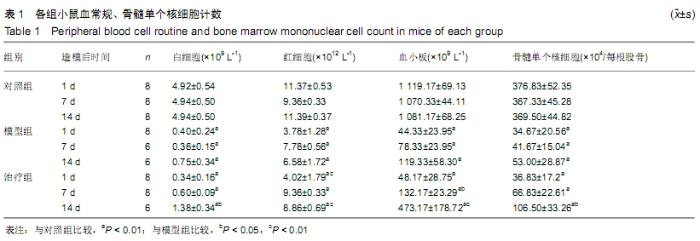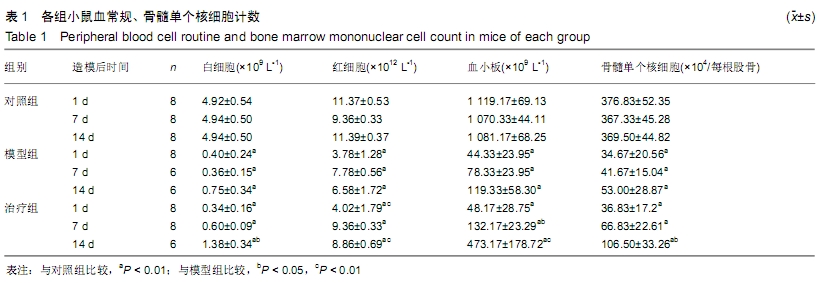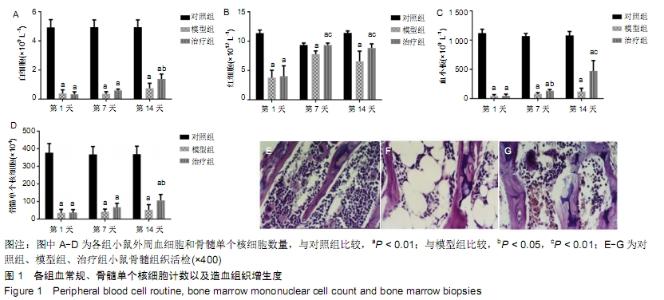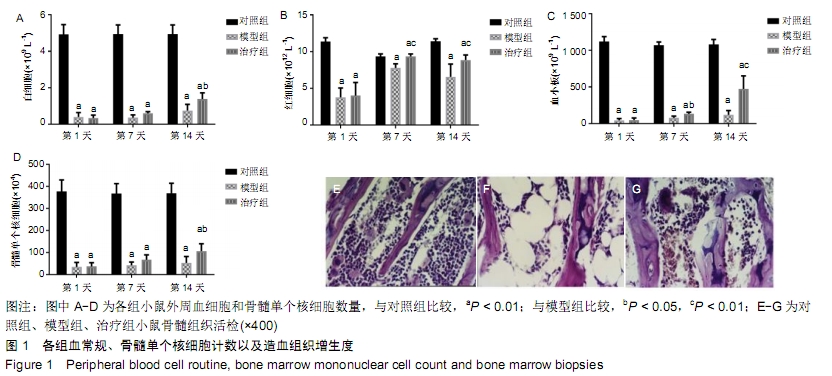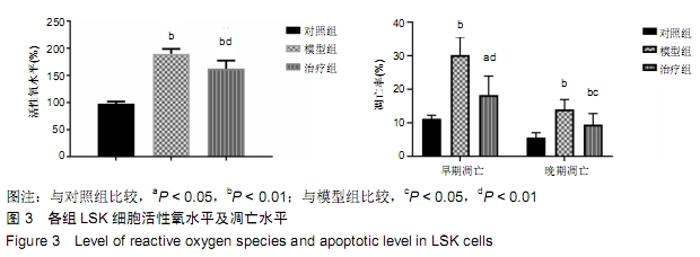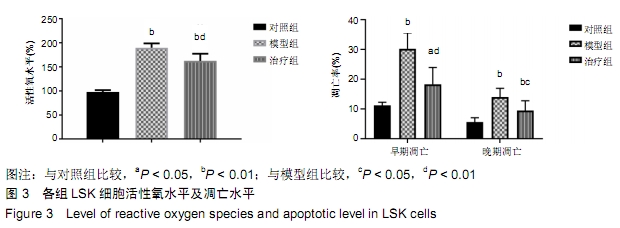[1] FORESTER CM, SARTAIN SE, GUO D, et al. Pediatric aplastic anemia and refractory cytopenia: A retrospective analysis assessing outcomes and histomorphologic predictors. Am J Hematol. 2015;90(4):320-326.
[2] CHATTERJEE R, LAW S. Epigenetic and microenvironmental alterations in bone marrow associated with ROS in experimental aplastic anemia. Eur J Cell Biol. 2018;97(1): 32-43.
[3] CHINNERY PF, SCHON EA. Mitochondria. J Neurol Neurosurg Psychiatry. 2003;74(9):1188-1199.
[4] CUI X, WANG J, CAI Z, et al. Complete sequence analysis of mitochondrial DNA and telomere length in aplastic anemia. Int J Mol Med. 2014;34(5):1309-1314.
[5] CHIU TL, SU CC. Tanshinone IIA induces apoptosis in human lung cancer A549 cells through the induction of reactive oxygen species and decreasing the mitochondrial membrane potential. Int J Mol Med. 2010;25(2):231-236.
[6] 宁炼,陈长勋,金若敏,等.当归补血汤促进造血功能的成分及其作用的研究[J].中国中药杂志,2002,27(1):50-53.
[7] LEE JG, HSIEH WT, CHEN SU, et al. Hematopoietic and myeloprotective activities of an acidic Angelica sinensis polysaccharide on human CD34+ stem cells. J Ethnopharmacol. 2012;139(3):739-745.
[8] XIAO H, XIONG L, SONG X, et al. Angelica sinensis Polysaccharides Ameliorate Stress-Induced Premature Senescence of Hematopoietic Cell via Protecting Bone Marrow Stromal Cells from Oxidative Injuries Caused by 5-Fluorouracil. Int J Mol Sci. 2017;18(11): E2265.
[9] 张先平,王乾兴,陈斌,等.当归多糖抑制氧化损伤延缓造血干细胞衰老[J].中国中药杂志,2013,38(3):407-412.
[10] 张先平,刘俊,徐春燕,等.当归多糖对小鼠衰老造血干细胞端粒、端粒酶及P53的影响[J].中国中药杂志, 2013,38(14): 2354-2358.
[11] CHEN YF, WU ZM, XIE C, et al. Expression level of IL-6 secreted by bone marrow stromal cells in mice with aplastic anemia. ISRN Hematol. 2013;2013:986219.
[12] 徐瑞荣,崔兴,王琰,等.当归补血汤促进小鼠骨髓移植后造血组织重建的研究[J].中国实验方剂学杂志,2008,14(10):39-41.
[13] VASAM G, JOSHI S, JARAJAPU YP. Impaired Mobilization of Vascular Reparative Bone Marrow Cells in Streptozotocin-Induced Diabetes but not in Leptin Receptor-Deficient db/db Mice. Sci Rep. 2016;6:26131.
[14] 毛宇,徐芳,邹云,等.当归多糖对造血功能的影响及其机制的研究[J].食品研究与开发,2015,36(8):122-126.
[15] 王改琴,景鹏,贾书花.当归多糖对小鼠骨髓造血干细胞及基质细胞表面细胞间黏附分子1水平的影响[J].中国组织工程研究, 2017,21(21):3293-3298.
[16] 张静,崔兴,陈维达,等.当归多糖干预调节再生障碍性贫血小鼠骨髓单个核细胞线粒体自噬稳态的实验研究[J].中药药理与临床, 2019,28(18):1939-1942.
[17] WALLACE DC. A mitochondrial paradigm of metabolic and degenerative diseases, aging, and cancer: a dawn for evolutionary medicine. Annu Rev Genet. 2005;39:359-407.
[18] CLAY MONTIER LL, DENG JJ, BAI Y. Number matters: control of mammalian mitochondrial DNA copy number. J Genet Genomics. 2009;36(3):125-131.
[19] HATFILL SJ, LA COCK CJ, LAUBSCHER R, et al. A role for mitochondrial DNA in the pathogenesis of radiation-induced myelodysplasia and secondary leukemia. Leuk Res. 1993;17(11):907-913.
[20] CHATLA S, DU W, WILSON AF, et al. Fancd2-deficient hematopoietic stem and progenitor cells depend on augmented mitochondrial translation for survival and proliferation. Stem Cell Res. 2019;40:101550.
[21] GATTERMANN N. Mitochondrial DNA mutations in the hematopoietic system. Leukemia. 2004;18(1):18-22.
[22] HALVARSSON C, RÖRBY E, ELIASSON P, et al. Putative Role of Nuclear Factor-Kappa B But Not Hypoxia-Inducible Factor-1α in Hypoxia-Dependent Regulation of Oxidative Stress in Hematopoietic Stem and Progenitor Cells. Antioxid Redox Signal. 2019;31(3):211-226.
[23] ZHANG P, DU J, ZHAO H, et al. Radioprotective effects of roxadustat (FG-4592) in haematopoietic system. J Cell Mol Med. 2019;23(1):349-356.
[24] KOOK SH, CHEON SR, KIM JH, et al. Dietary hydroxycinnamates prevent oxidative damages to liver, spleen, and bone marrow cells in irradiation-exposed mice. Food Sci Biotechnol. 2017;26(1):279-285.
[25] NIU X, ZHANG J, LING C, et al. Polysaccharide from Angelica sinensis protects H9c2 cells against oxidative injury and endoplasmic reticulum stress by activating the ATF6 pathway. J Int Med Res. 2018;46(5):1717-1733.
[26] XIAO H, XIONG L, SONG X, et al. Angelica sinensis Polysaccharides Ameliorate Stress-Induced Premature Senescence of Hematopoietic Cell via Protecting Bone Marrow Stromal Cells from Oxidative Injuries Caused by 5-Fluorouracil. Int J Mol Sci. 2017;18(11): E2265.
[27] BEJANYAN N, KIM S, HEBERT KM, et al. Choice of conditioning regimens for bone marrow transplantation in severe aplastic anemia. Blood Adv. 2019;3(20):3123-3131.
[28] FATTIZZO B, KULASEKARARAJ AG, HILL A, et al. Clinical and morphological predictors of outcome in older aplastic anemia patients treated with eltrombopag. Haematologica. 2019;104(11):e494-e496.
[29] GONZAGA VF, WENCESLAU CV, LISBOA GS, et al. Mesenchymal Stem Cell Benefits Observed in Bone Marrow Failure and Acquired Aplastic Anemia. Stem Cells Int. 2017;2017:8076529.
|
